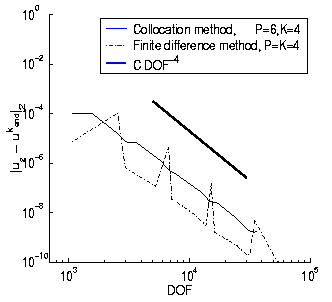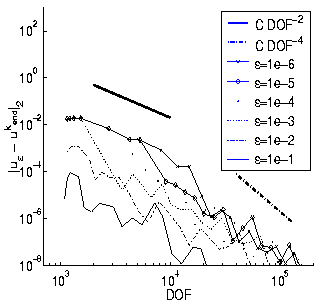We want to solve the Poisson problem
 + Dirichlet
boundary conditions
+ Dirichlet
boundary conditions
The common cycle of sucessive solution
of the PDE with a given trial space and the a subsequent refinement depending
on the current solution is used. In our case, the current index sets is
augmented by neighbours of indices with large wavelet coefficients.
First example:
The right hand side is such that the true
solution is u(x,y)=sin(3Pi x)sin(3Pi y) . In this case, regular
sparse grids would be optimal. However, we don't want to use this information,
except it tells us how fast the numerical solution can converge, if the
refinement strategy and the discretization do not deteriorate the convergence
rate. 4th order Interpolets and a 4th order finite difference scheme have
been used in this experiment. The figure below shows the numerical error
vs. the number of used degrees of freedom. The observed conver- gence rate
of 4 is optimal.

Second example:
The right hand side is such that the true
solution is u(x,y)=(eps^2 + |x-x0|^2 + |y-y0|^2) ^ (1/4).
This is a regularized variant of a function with a square root singulratity
in (x0,y0) \in ]0,1[^2. The regularization parameter eps
was chosen between 10^(-6) and 0.1 . Again 4th
order Interpolets and a 4th order FD scheme were used. The convergence
behaviour is more complicated for this example. When the number of DOF
is relatively small the scheme doesn't see the regularization and it converges
with a rate of 2 which is optimal. However, for sufficiently large number
of DOF and active levels, the regularization comes into play and the convergence
rate increases to 4 which is optimal for smooth functions. Unfortunately,
the convergence is not very regular. There is much room for improvements.

|